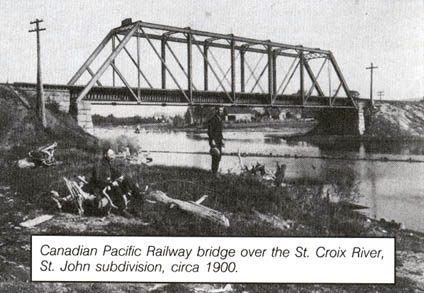Vol. 17 No. 7
July, 1987
|
Stay Safe in 87
|
|

"International of
Maine" Fondly Remembered
|

Omer Lavallee
|

The recent preoccupation with CP Rail
centennials in Western Canada tends to overshadow a significant anniversary in the East. It was just 100 years ago
this spring that Canadian Pacific began work in Maine to complete construction of the Moosehead and Mattawamkeag
Subdivisions of the Saint John Division, better known as the "International of Maine".
This was the last section to be built of the aptly-named "Short Line", a
774-kilometre eastward extension of the transcontinental between Montreal and the Atlantic Coast at
Saint John, New Brunswick.
As this railway is the subject of my current book, facts are conveniently at hand. I felt, therefore, that it would
be appropriate to devote a column or two to the interesting, though somewhat complex, history of the eastern end of
the system.
A little more than half of the "Short Line" between Montreal and Saint John was built by a number of
earlier companies before the CPR came into the picture.
The oldest of these components is the 235-kilometre-long section between Saint John and Mattawamkeag,
Maine, which was built by two distinct companies. although one was incorporated in New Brunswick and the other in
Maine, both bore the same ambitious title, European & North American Railway (E&NA).
The E&NA (New Brunswick), which terminated at the international boundary at the St. Croix River, was opened in
1869. The E&NA (Maine) was completed between Bangor and the St. Croix in the autumn of 1871.
The United States railway network had reached Bangor long before, in 1855. As a result, from late in 1871, it became
possible, for the first time, to travel by rail exclusively between the rest of the continent and the Maritimes.
This was five years before the Intercolonial Railway, a rival all-Canadian rail link between Montreal
and Halifax by way of Campbellton and Moncton, N.B., was available.
The two E&NA companies capitalized on the event by organizing an international celebration, with many invited
dignitaries headed by US President, Ulysses S. Grant, and the Earl of Lisgar, governor-general of
Canada.
On 19 Oct 1871, the party, made up of 1,300 guests, climbed aboard a special 15-car train
headed for Vanceboro, where President Grant drove the last spike at the St. Croix bridge.
After a sumptuous lunch served in tents, some 200 of the guests went over the Canadian section, to attend another
"feed" at the Victoria Hotel in Saint John. Although President Grant was invited to come along, protocol
at that time seems to have prevented any US president from leaving his own territory, and he had to decline.
Since the two lines had a common purpose, the New Brunswick and Maine companies were governed by one management
beginning in 1872. However, financial difficulties resulted in the arrangement being terminated in 1875. The E&NA
of Maine retained its corporate identity, but its New Brunswick counterpart was reorganized as the St. John &
Maine Railway Company.
The completion of the E&NA drew the attention of several Canadian promoters, headed by John Henry Pope of
Cookshire, Quebec, who were promoting a railway eastward from Lennoxville, Quebec. (on the Grand Trunk Railway) to
Megantic, Quebec.
The Pope group saw the advantages of lining up its own line - the St. Francis & Megantic International Railway
(SF&MI) - with the E&NA of Maine at Mattawamkeag, north of Bangor, passing by way of Moosehead Lake.
The resulting meeting of minds between the Pope group and the E&NA of Maine resulted, in 1871, in the granting of
a charter by the Maine Legislature for what would become the International Railway Company of Maine.
The SF&MI Railway, by the renamed International Railway Company, was opened east as far as Megantic in 1879; it
was extended to the Quebec-Maine boundary in 1883. Subsequently, some locating and grading was done in
Maine as far as Gulf Stream, just west of Holeb. However, rails were not put down on this section until the autumn
of 1886 as settlement in this area was virtually nonexistent. No public train service was offered east of Megantic
until the late 1880s.
The "International of Maine"story will continue next week.
This CP Rail News article is copyright
1987 by the Canadian Pacific Railway and is reprinted here with
their permission. All photographs, logos, and trademarks are the property of the Canadian Pacific Railway
Company.
|